Zzyzx (Huh? What?)
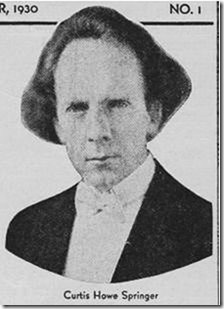 Curtis Howe Springer was a phantasmagorical mix of labels – – minister, soldier, medical doctor, evangelist, college professor, entrepreneur, real estate developer, miner, and charlatan. All but the last were self-proclaimed – – intriguing evidence of the limitless deceptions of con men throughout the world.
Curtis Howe Springer was a phantasmagorical mix of labels – – minister, soldier, medical doctor, evangelist, college professor, entrepreneur, real estate developer, miner, and charlatan. All but the last were self-proclaimed – – intriguing evidence of the limitless deceptions of con men throughout the world.
In 1944, Curtis migrated his long-standing radio-evangelist job to the arid southwest, and single-handedly created the Zzyzx “empire”, coining the name to be sure it was the last in any alphabetical listing. He was using fraudulent techniques to establish a mining claim on desert land, and then create a “health spa” using the local spring waters as tonics. His mixes of vegetable juices were claimed to resolve health issues from hair loss to cancer. And enough folks bought the story that Curtis’ dream prevailed for almost 30 years. By 1969, he had achieved more than a little notoriety, achieving the title “King of Quacks” by the AMA. He had also begun to sub-divide his “claim” and sell off parcels of government land. Shortly later, in 1974, it was revealed that he had no claim whatsoever to the land on which he squatted. The BLM re-claimed the territory, and a brief stint in jail sent Curtis along his way and left Zzyzx unattended. The venerable Mr./Dr./Honorable Springer spent the last ten years of his life in anonymity and died in 1985 at the age of 88.
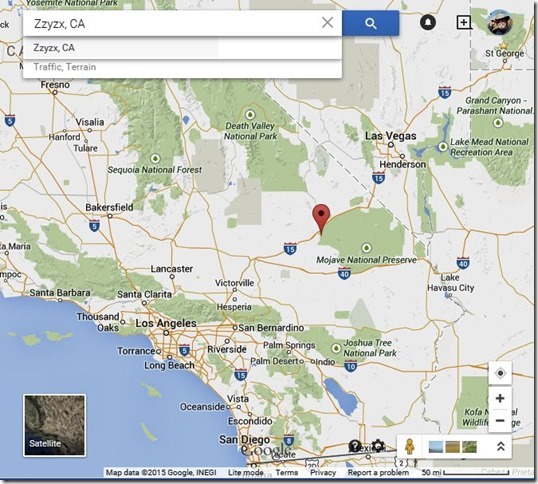
If this leaves you in any way curious, you can get a lot more details starting here: http://en.wikipedia.org/wiki/Zzyzx,_California
Since Curtis departed company with Zzyzx, the land was quickly taken over by California State University (CSU). Turns out that one of Curtis’ boondoggles, the spa pool, had become home to an endangered fish species (the tui chub). This, and other considerations, spawned (no pun intended) the Desert Studies Center. Today, the Center is a popular attraction for biologists interested in the variety of species attracted to desert environments with water resources.
It was also attractive to us, simply because we had never visited it before. There’s no camping or even overnight parking at the Center, so we wandered back eastward a bit and found a nice spot just 50 yards off the road. In the last 20 hours, there have been 8 cars go by. Nice spot.
As you can see from the map, the Center is at the western edge of the Mojave Preserve, one of our all-time favorite desert destinations. The Preserve is extremely varied, ranging from private land parcels to full wilderness, paved roads to tiny dirt scratches clawing up the hillsides of old mining claims. It’s over 2,500 square miles of territory to explore and enjoy. We’ve spent time in the eastern portions but this is our first visit to the western area.
A Splendid Day
We woke in the AM to a perfect desert day, calm and balmy. After coffee and email (thanks to our Wilson booster), we hiked up the hill behind camp to get a higher view of our surrounds. 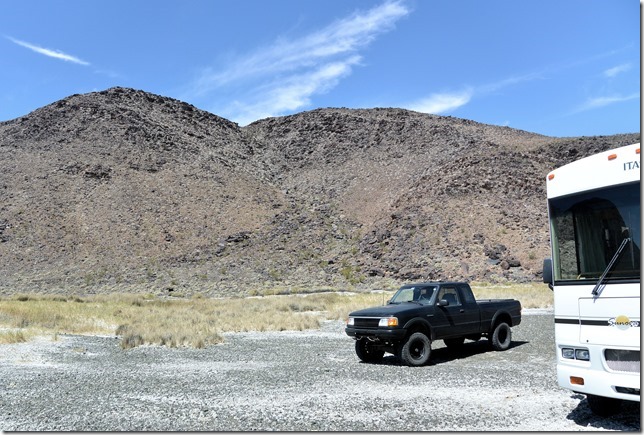
Dang!! It’s a rocky, steep slope with a loose mix of dirt and igneous stones. Just when you think you’ve got a great foothold, Crunch! and the rock slides away to leave you lurching for a new stability.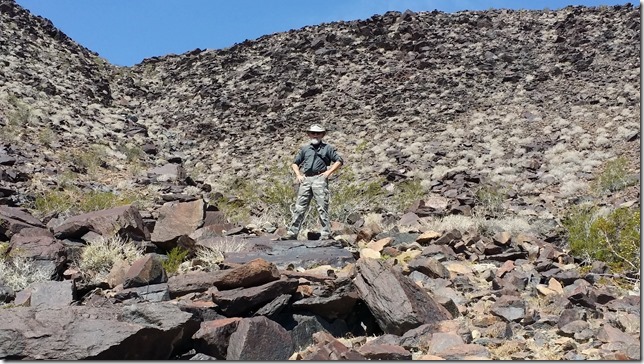
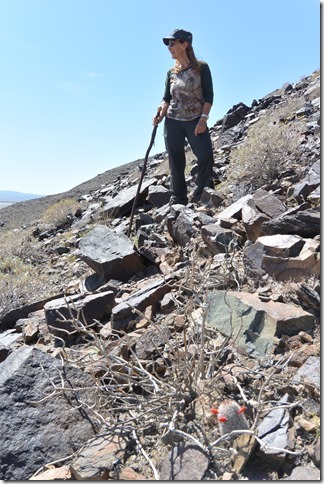
Along the way, tiny little buds sprout out on equally tiny cacti, creating little micro-flares on the austere hillside.
As we hike, the rocks have a glass/metal character that makes some of them ring like a dinner gong when they clink against each other. It’s like walking through metallic glass.
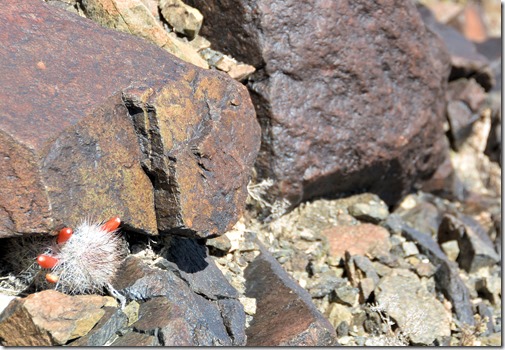
Far below us, Howie and Ralph watch calmly out over the expanse of the Preserve, placidly awaiting our return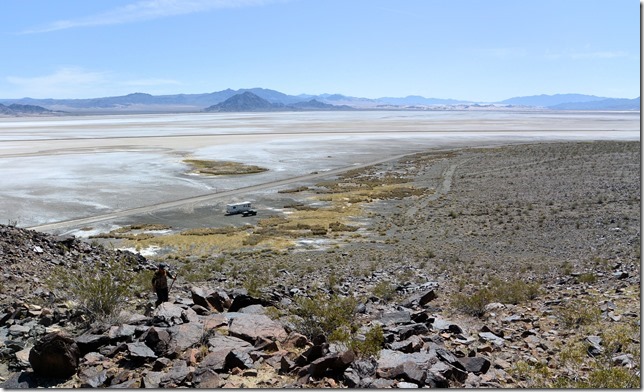
Down the road is the Center – – a quiet, almost deserted enclave of the old and new. This weekday, it’s empty and silent, but likely the weekend desert-study classes (by CSU) will increase the population and noise level a bit.
As we stroll about, a couple of mud ducks motor-boat across Tuendae. Hard to call it a Lake really, it’s much more kind of a medium-sized pond.
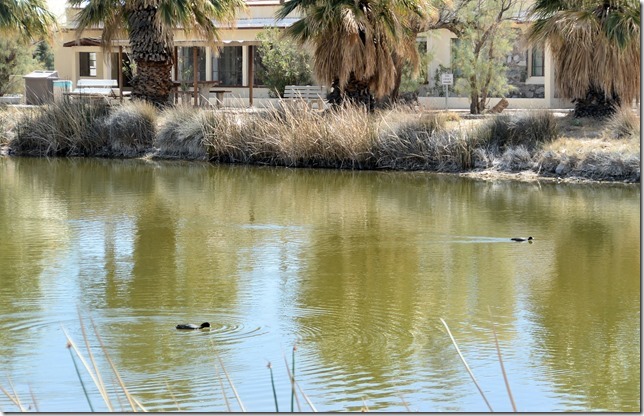
Out beyond the lake/pond, the Mojave calmly displays its magnificence.
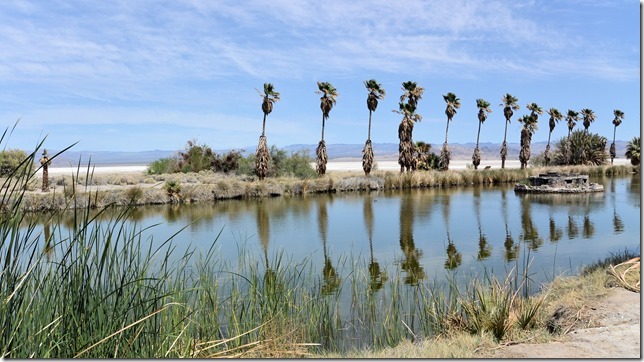
Once upon a time, it must have been worth putting a boat on the waters. Not so much these days.
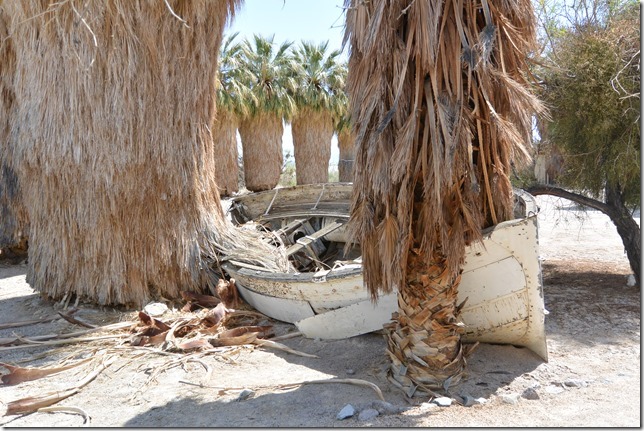
The spacious bath houses and dreamy street names belie the CSU weekend activities and the previous population.
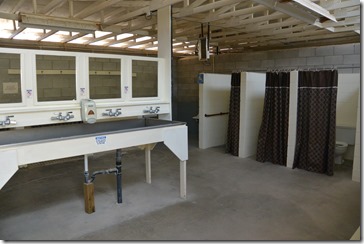
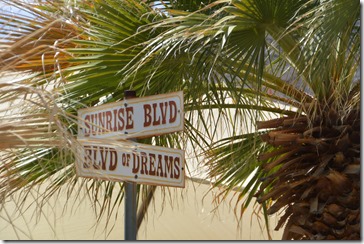
But now (weekdays), it’s still a pretty small-time operation. No staff is in evidence on a Wednesday afternoon.
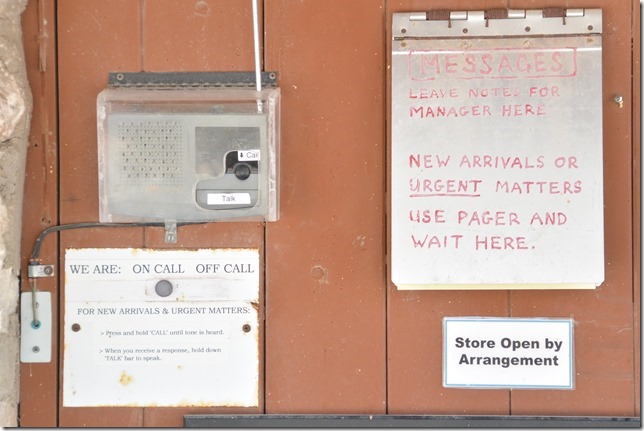
After touring the Center, we decided to take Ralph and go explore some other areas. The best way to get there was via I-15, and, maddeningly, there was yet ANOTHER miles-long traffic jam to deal with. [We later learned a big horse-trailer had overturned, causing an hours-long tie-up.]

We elected to take “back roads” more or less parallel to the freeway, and get past the thousands of cars and trucks parked in our way. The road was dirt, rough, and occasionally needing 4WD, but still faster than sitting still behind a big semi.
So – – imagine our surprise to find a small passenger car, front-wheel-drive, buried to its door-sills in the soft sand along the tiny dirt road.
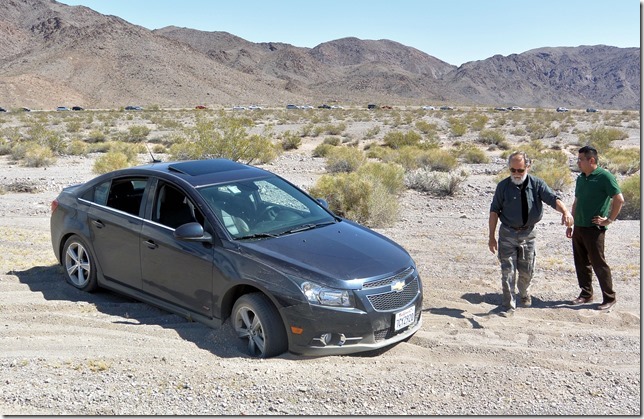
Javier (the driver) had decided to bypass the traffic, but had seriously over-estimated his Chevy. He was totally buried, up to the axles and the belly pan. He had called the highway patrol for help, but as yet none had arrived.
We tried digging him out, but the sand was so soft and deep that it was not a successful ploy.
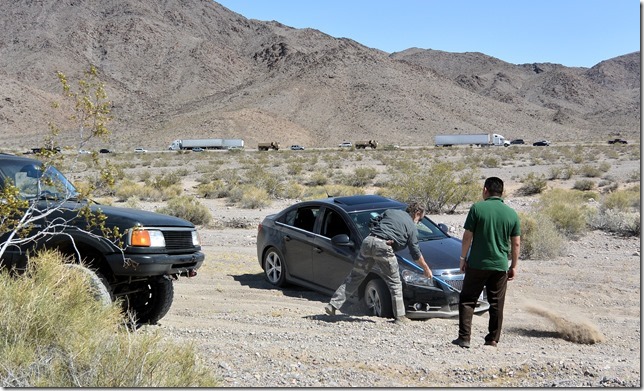
Next, we pulled him free with 4WD and a snatch strap, getting him up on solid ground again.
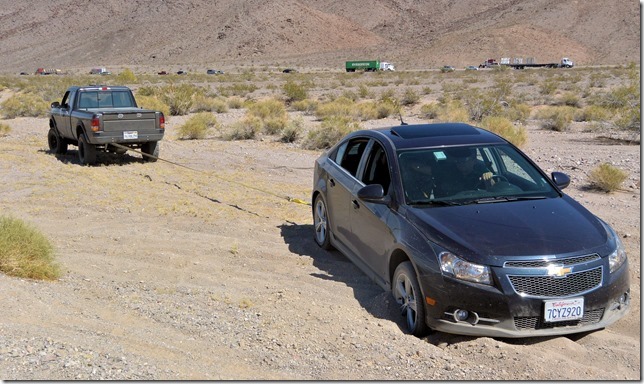
But alas, no amount of gentle prodding was going to get that car out of the soft area and back on terra firma. Even with my considerable off-road experience, I only managed to get his car stuck once again.
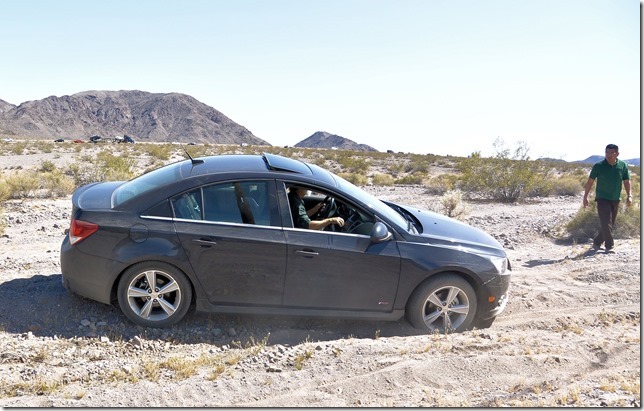
Javier and I had talked at length at how he was going to get back to pavement. He was half-convinced that he could continue travelling the up-hill four more miles ahead, and I was trying to talk him into retracing his steps back the shorter, downhill two miles to Zzyzx. While we were reviewing his options, a third party came along – – the guy summoned by his CHP call. This guy also recommended going back. In addition, for his call-out fee ($200), he also guaranteed shepherding Javier all the way back to solid ground, freeing him if he got stuck again (something we weren’t quite prepared to sign up to).
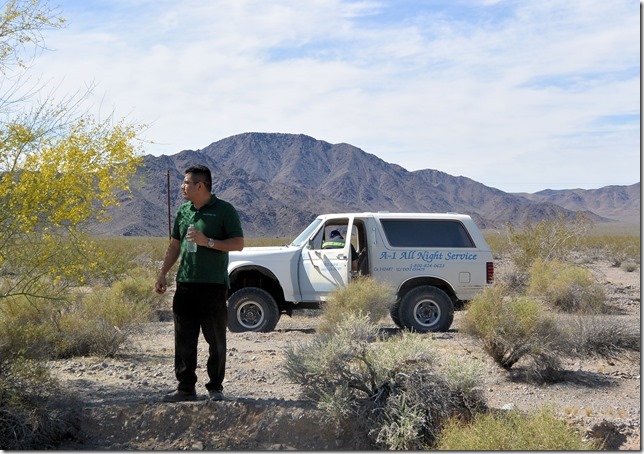
In the end, Javier saw the wisdom and placed himself under the care of the rescue guy. We were then free (emotionally speaking) to continue our explorations.
Once again, down I-15 (now free and clear) and off to the Afton Canyon campground. What is this about our luck, anyway? Campground CLOSED March through June. Go figure.
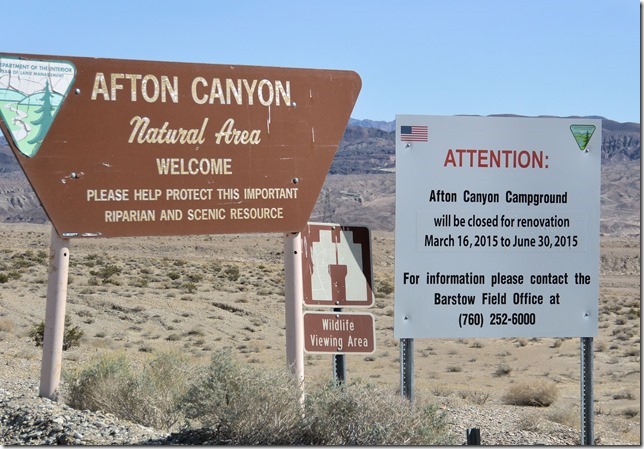
Undismayed (aw, we didn’t want to camp here anyway), we trundled on down the road to have a look. Turns out, the campground, though “closed”, was well populated. But we really weren’t there to do anything except reconnoiter, so on we went.
Our guidebook warned about some “relatively deep” river crossings, and we were not disappointed. The first one was somewhat intimidating. About 100 feet across, potentially muddy, and no idea how deep. Nothing to winch to or any place to dig out from. While we were pondering our chances, another vehicle showed up on the far “shore”.
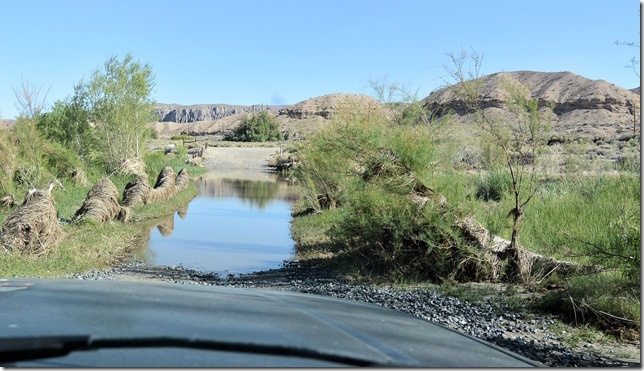
This guy was kind enough to ford towards us from the opposite direction (he had already gone through the opposite way), and I was kind enough (read that “chicken enough”) to let him go first.
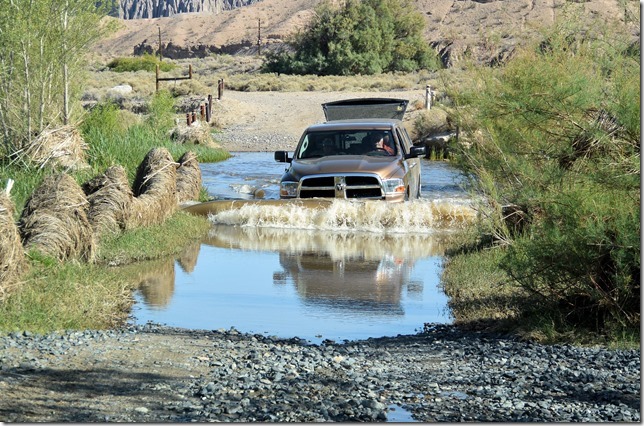
It still didn’t fill me with confidence. Ralph has 18” of belly clearance and almost 24” of body clearance – – so it was a little unnerving to think of the water lapping at the bottom edges of our high-flung doors. Nevertheless, on we trucked. WOW – – that exhaust sure does get quiet when it goes under water!!
The next crossing was under the railroad bridge. Scariest part of a fording is that you can’t see the bottom, there are no winch points, and you know that if it’s deep enough, the water will come inside your cab and the engine will likely quit. Very messy, very expensive.
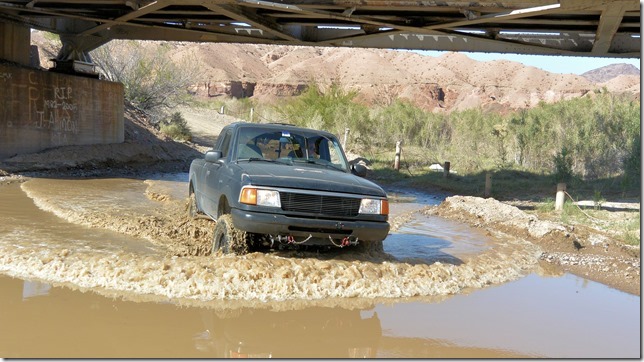
The final fording was the worst, a real butt-pucker affair. Wide, deep, muddy, with occasional big rocks and holes in the invisible bottom – – I had to crawl through to avoid suspension breakage, resulting in no momentum available to get past the sticky spots. Fortunately, Ralph’s setup is sound, and the bottom was not too bad. We drove it through (but Karin walked the bridge so she could take the photos).
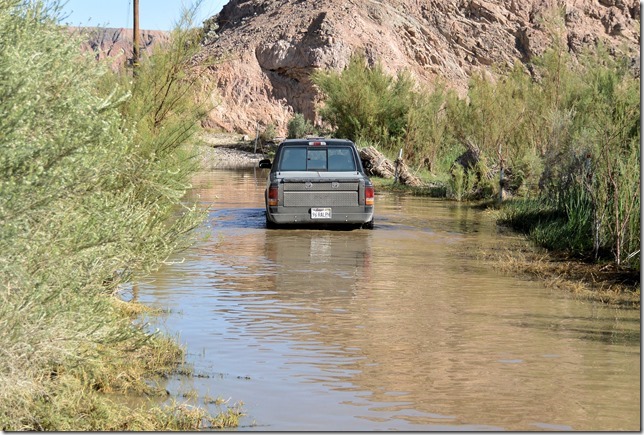
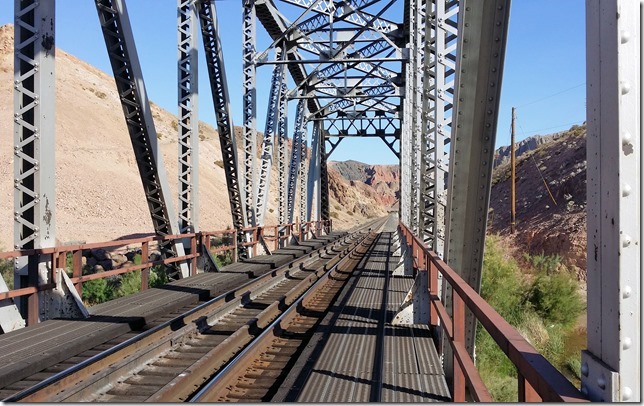
Finally free of the River, we could take some time to appreciate the beauty of its canyon.
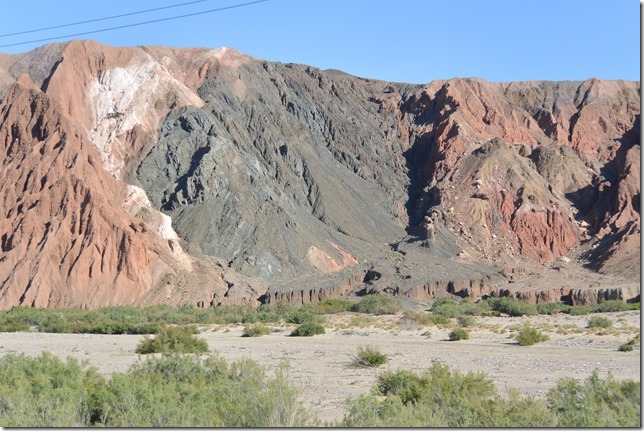
And check out some of the railroad maintenance equipment at the Basin Siding.
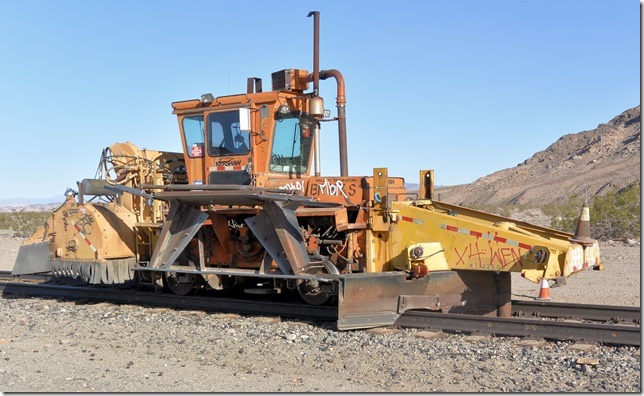
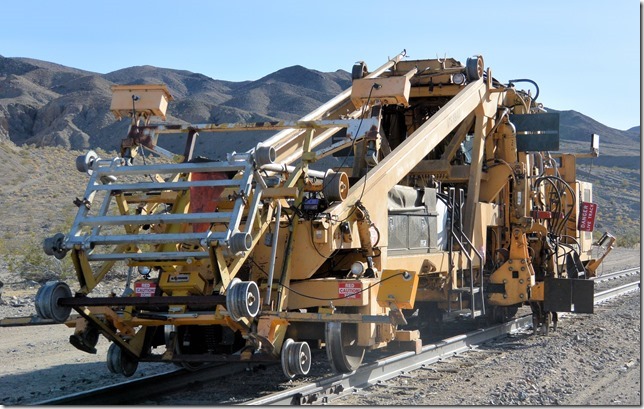
In all of our ramblings, we hadn’t seen anyone since the guy crossed the Mojave River in front of us. But when we decided to exit back to I-15, of course we had to wait for a passing train. Simple stop sign, no lights, no safety bar, just this big dang train. There was an underpass where we could have sneaked through, but it was a mile back, in soft sand, and pretty low clearance. We just waited, and used the road.
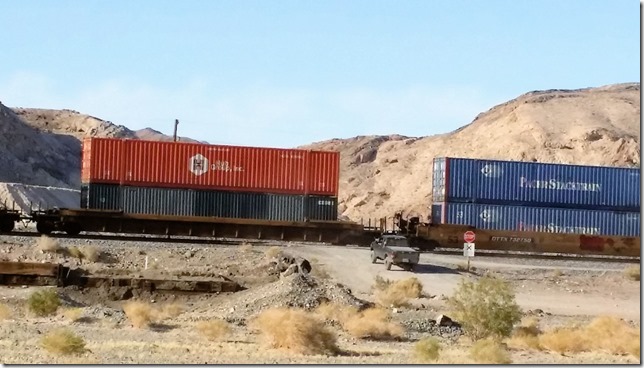
The return road snaked back through an old mining area, with its road/rail-bed and stone walls, and then wound through the foothills of the Mojave Wash and back to I-15.
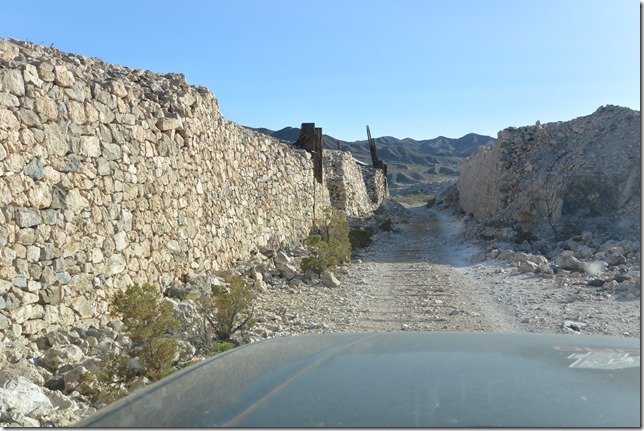
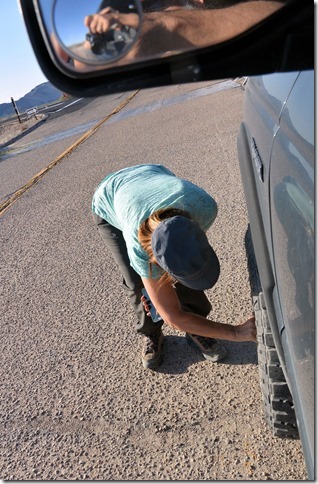 Karin was kind enough to un-lock Ralph’s hubs, and we made the uneventful highway trip back to camp. No traffic jams, thankfully.
Karin was kind enough to un-lock Ralph’s hubs, and we made the uneventful highway trip back to camp. No traffic jams, thankfully.
It seemed like quite a full day.

Inspiring to see what you’re up to when not involved with designing church entryways. I’m thinking how I’d love to take some of your adventures with my grandson Asa when he’s a bit older…. at least weaned and maybe potty-trained.
.
Aw, he doesn’t need potty-training. Just sit him out in the woods for a little bit.
I’ve always wondered what Zzyzx road exit on highway 15 was named after. Now i know! Fascinating!
Greg and Karen..nice and interesting pictures..rough terain looks like a challenge ..fascinating..till next..tony/marlene
HI Greg & Karin!
What an adventure. All in a normal day for you two.
We saw a Bowlus Road Chief today and got a tour. Maria is ready to pack it all in and hit the road.
See you guys on the 25th!
Mike & Maria
Looks like a fun day. I really liked the picture of the canyon- after the picture of the bridge. It has some very interesting rock formations.
What was the purpose of the stone walls along the road shown in the second to the last picture?
Those mosaic-style stone walls are a common feature in old mining areas, due to the availability of the stone. Walls were built for a variety of reasons, such as building-walls and retaining-walls. They were also built for equal-level access to rail cars for loading and unloading. The ones you saw were probably retaining walls, to hold back rock and debris while the rail bed maintained its level.